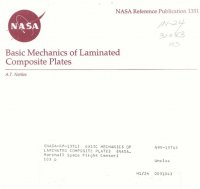I simply wanted to know and then thought I would share.
Basic Fact #1: Think of CF as a rope, it is ONLY strong in 1 direction, tension, exactly like a rope! Push (compression) a rope - weak, pull (tension) a rope - strong! CF in shear (across) not so strong, CF is brittle & does not like to bend, it shatters much like glass/ceramics.
Note: Metals are the same strength in all directions of tension (not necessarily compression but better than CF), unlike CF which is ONLY strong in only 1 uniform direction.
Basic Fact #2: The 3k, 6k, 12k, etc refers to the # of 'thousands' of filaments (around 7 microns) woven forming a strand of CF in the cloth/fabric, loose CF it seems a bit harder to quantify this aspect, but would imply the 'groups/chunks/threads' of fibers together of similar count - I believe.
(cool pics of CF fabric - http://www.fibreglast.com/category/carbon_fiber_all)
Basic Fact #3: Air/bubbles/globs of epoxy/etc, ie VOIDS weaken CF and must be avoided/eliminated. Many CF objects (tubes-maybe, but certainly complex shaped CF things) use vacuum sealing inside of a 'bag' where a strong vacuum attempts to eliminate 'voids' by pressing out these voids.
Basic Fact #4: CF must be heated to remove ALL but the carbon in the fibers/epoxy/material to get greatest strength (epoxy is weak).
Basic Fact #5: CF MUST be constructed to behave (show strength) as desired, meaning, construction creates the strong direction(s) unlike metals which are uniform in strength.
Basic Fact #6: There are 3 major categories of CF (how the actual CF filaments are made), 1) High Modulus Carbon Fiber (Aerospace Grade), 2) Intermediate Modulus Carbon Fiber, 3) Standard Modulus Carbon Fiber (Commercial Grade). It is the later that copters use and most anything we see as 'normal' ppl, and the price is in the same order obviously.
Carbon Fiber Prepreg - High Performance and Quality (but cost effective)
The majority of the carbon fiber tubes produced are made using multiple layers of unidirectional (UD) carbon fibers (loose not woven fabric) in an epoxy resin. This form of carbon fiber is called prepreg, where the carbon fibers (loose or fabric) are pre-impregnated (prepreg) with an epoxy resin.
UD carbon fiber prepreg is used because it ensures the best properties possible of carbon fiber tubing in terms of strength and stiffness, and it is also a cost effective form of carbon fiber. This provides the best value in carbon fiber tubing - bar none. Pre-preg helps with eliminating voids as well.
Carbon fiber fabric/cloth prepreg is also used extensively, but mainly on the exterior of the carbon fiber tubing for aesthetic and cosmetic reasons.
(My impression of the difference is that the non fabric is a slurry of aligned CF strands in epoxy, whereas the CF fabric is woven just like clothing cloth)
The above is likely how all the Chinese CF tubing is made, the base being NON fabric CF with a surface of CF fabric.
The above is likely NOT the strongest tubing but a cost compromise & generally good enough for most uses.
The strongest CF tubing may or may not have an 'inner' tube of some kind (strong plastic, alum, cro-moly, etc) ie - w/ CF wrapping, but would be much more completely made of wrappings of Carbon fiber 'fabric' not just Carbon fibers inpregnated material, with wrapped layers w/ different strand orientations at some angle but with CF strand emphasis along the axis of desired maximum stiffness/strength.
For complex shapes, proprietary software designs the layers, shapes & sizes of CF fabric (or CF non fabric base) to give the desired stiffness, elasticity & directions of strength. Very complex stuff - ask a Formula One chassis designer or the quite elastic front wing designers, seriously !
Tubes are simple ! Or are they?
Sometimes absolute stiff is NOT what you want, some give is needed in the real world for many uses, but stiff is what we want for motor beams/structs/cantilevers !! Flexibility is what we want during a crash!! See the compromise issue!
This is OBVIOUSLY a cursory glance, NOT by a CF expert but it answered many of my questions, now how to compare to CF tubes to metal/alum motor beams/structs for strength/stiffness/weight/cost ??
Correct me where I am wrong !
Thanks!
Basic Fact #1: Think of CF as a rope, it is ONLY strong in 1 direction, tension, exactly like a rope! Push (compression) a rope - weak, pull (tension) a rope - strong! CF in shear (across) not so strong, CF is brittle & does not like to bend, it shatters much like glass/ceramics.
Note: Metals are the same strength in all directions of tension (not necessarily compression but better than CF), unlike CF which is ONLY strong in only 1 uniform direction.
Basic Fact #2: The 3k, 6k, 12k, etc refers to the # of 'thousands' of filaments (around 7 microns) woven forming a strand of CF in the cloth/fabric, loose CF it seems a bit harder to quantify this aspect, but would imply the 'groups/chunks/threads' of fibers together of similar count - I believe.
(cool pics of CF fabric - http://www.fibreglast.com/category/carbon_fiber_all)
Basic Fact #3: Air/bubbles/globs of epoxy/etc, ie VOIDS weaken CF and must be avoided/eliminated. Many CF objects (tubes-maybe, but certainly complex shaped CF things) use vacuum sealing inside of a 'bag' where a strong vacuum attempts to eliminate 'voids' by pressing out these voids.
Basic Fact #4: CF must be heated to remove ALL but the carbon in the fibers/epoxy/material to get greatest strength (epoxy is weak).
Basic Fact #5: CF MUST be constructed to behave (show strength) as desired, meaning, construction creates the strong direction(s) unlike metals which are uniform in strength.
Basic Fact #6: There are 3 major categories of CF (how the actual CF filaments are made), 1) High Modulus Carbon Fiber (Aerospace Grade), 2) Intermediate Modulus Carbon Fiber, 3) Standard Modulus Carbon Fiber (Commercial Grade). It is the later that copters use and most anything we see as 'normal' ppl, and the price is in the same order obviously.
Carbon Fiber Prepreg - High Performance and Quality (but cost effective)
The majority of the carbon fiber tubes produced are made using multiple layers of unidirectional (UD) carbon fibers (loose not woven fabric) in an epoxy resin. This form of carbon fiber is called prepreg, where the carbon fibers (loose or fabric) are pre-impregnated (prepreg) with an epoxy resin.
UD carbon fiber prepreg is used because it ensures the best properties possible of carbon fiber tubing in terms of strength and stiffness, and it is also a cost effective form of carbon fiber. This provides the best value in carbon fiber tubing - bar none. Pre-preg helps with eliminating voids as well.
Carbon fiber fabric/cloth prepreg is also used extensively, but mainly on the exterior of the carbon fiber tubing for aesthetic and cosmetic reasons.
(My impression of the difference is that the non fabric is a slurry of aligned CF strands in epoxy, whereas the CF fabric is woven just like clothing cloth)
The above is likely how all the Chinese CF tubing is made, the base being NON fabric CF with a surface of CF fabric.
The above is likely NOT the strongest tubing but a cost compromise & generally good enough for most uses.
The strongest CF tubing may or may not have an 'inner' tube of some kind (strong plastic, alum, cro-moly, etc) ie - w/ CF wrapping, but would be much more completely made of wrappings of Carbon fiber 'fabric' not just Carbon fibers inpregnated material, with wrapped layers w/ different strand orientations at some angle but with CF strand emphasis along the axis of desired maximum stiffness/strength.
For complex shapes, proprietary software designs the layers, shapes & sizes of CF fabric (or CF non fabric base) to give the desired stiffness, elasticity & directions of strength. Very complex stuff - ask a Formula One chassis designer or the quite elastic front wing designers, seriously !
Tubes are simple ! Or are they?
Sometimes absolute stiff is NOT what you want, some give is needed in the real world for many uses, but stiff is what we want for motor beams/structs/cantilevers !! Flexibility is what we want during a crash!! See the compromise issue!
This is OBVIOUSLY a cursory glance, NOT by a CF expert but it answered many of my questions, now how to compare to CF tubes to metal/alum motor beams/structs for strength/stiffness/weight/cost ??
Correct me where I am wrong !
Thanks!


